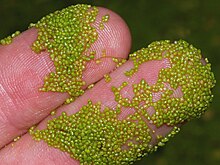| Wolffia arrhiza | |
|---|---|

| |

| |
| Conservation status | |
 Least Concern (IUCN 3.1) | |
| Scientific classification | |
| Kingdom: | Plantae |
| Clade: | Tracheophytes |
| Clade: | Angiosperms |
| Clade: | Monocots |
| Order: | Alismatales |
| Family: | Araceae |
| Genus: | Wolffia |
| Species: | W. arrhiza |
| Binomial name | |
| Wolffia arrhiza (L.) Horkel ex Wimm. | |
| Synonyms | |
| |
Wolffia arrhiza, commonly known as spotless watermeal or rootless duckweed, is a species of flowering plant in the Araceae family, which includes other water-loving plants such as Arum and Pistia. It is the smallest vascular plant on Earth. Native to Europe, Africa, and parts of Asia, it has also naturalized in various other regions around the globe.
Description
Wolffia arrhiza is an aquatic plant which grows in quiet water bodies such as ponds. The plant’s green part, known as the frond, is a spherical structure about 1 mm wide. It has a flat top that allows it to float on the water’s surface. It has a few parallel rows of stomata. There is no root. The plant produces a tiny flower, complete with one stamen and one pistil. Many morphologists consider these to be an inflorescence of one tiny male flower 1/75th inch (0.33 mm) in height with a single female flower 1/80th inch (0.3 mm) in diameter; the smallest inflorescence to be reported. It often multiplies by vegetative reproduction, with the rounded part budding off into a new individual. In cooler conditions, the plant becomes dormant and sinks to the bottom of the water body to overwinter as a turion. As a mixotroph, it can produce its own energy by photosynthesis or absorb it from the environment in the form of dissolved carbon.
Taxonomy
Wolffia arrhiza was first described in 1771 by L. as Lemna arrhiza to the genus Lemna known for several duckweed species. It was transferred to the current genus Wolffia in the 19th century based on works of Johann Horkel and the third edition of the Flora von Schlesien preußischen und österreichischen Antheils by Christian Friedrich Heinrich Wimmer in 1857.
Human uses
This tiny plant is a nutritious food. Its green part is about 40% protein by dry weight and its turion is about 40% starch. It contains many amino acids important to the human diet, relatively large amounts of dietary minerals and trace elements such as calcium, magnesium, and zinc, and vitamin B12. It has long been used as a cheap food source in Myanmar, Laos, and Thailand, where it is known as khai-nam ("eggs of the water"). The plant is prolific in its reproduction, growing in floating mats that can be harvested every 3 to 4 days; it has been shown to double its population in less than four days in vitro.
It is also useful as a form of agricultural and municipal water treatment. It is placed in effluent from black tiger shrimp farms to absorb and metabolize pollutants. The plants grow quickly and take up large amounts of nitrogen and phosphorus from the water. The plants that grow in the wastewater can then be used as feed for animals, such as carp, Nile tilapia, and chickens.
References
- Lansdown, R.V. (2019). "Wolffia arrhiza". IUCN Red List of Threatened Species. 2019: e.T164241A120209232. doi:10.2305/IUCN.UK.2019-2.RLTS.T164241A120209232.en. Retrieved 30 April 2023.
- Pietryczuk, A., et al. (2009). The effect of sodium amidotrizoate on the growth and metabolism of Wolffia arrhiza (L.) Wimm. Polish Journal of Environmental Studies 18:5 885-91.
- ^ Pan, S. and S. S. C. Chen. (1979). The morphology of Wolffia arrhiza: A scanning electron microscopic study. Bot Bull Academia Sinica 20 89-95.
- ^ Czerpak, R., et al. (2004). Biochemical activity of auxins in dependence of their structures in Wolffia arrhiza (L.) Wimm. Archived 2011-09-11 at the Wayback Machine Acta Societatis Botanicorum Poloniae 73:4 269-75.
- "Wolffia arrhiza". Germplasm Resources Information Network. Agricultural Research Service, United States Department of Agriculture. Retrieved 2 January 2018.
- "Wolffia arrhiza in Flora of North America @ efloras.org". efloras.org.
- Heywood, Prof. V.H. (1978). Flowering plants of the World. New York: Mayflower Books. p. 307. ISBN 0-8317-3400-0.
- "MoBot: Wolffia arrhiza". Archived from the original on 2017-07-26. Retrieved 2010-12-05.
- ^ Al Khateeb, N. Duckweed use for sewage treatment and fodder production in Palestine. Water & Environmental Development Organization, Palestine.
- ^ Fujita, M., et al. (1999). Nutrient removal and starch production through cultivation of Wolffia arrhiza. Journal of Bioscience and Bioengineering 87:2 194-8.
- ^ Czerpak, R. and I. K. Szamrej. (2003). The effect of β-estradiol and corticosteroids on chlorophylls and carotenoids content in Wolffia arrhiza (L.) Wimm. (Lemnaceae) growing in municipal Bialystok tap water. Archived 2017-08-08 at the Wayback Machine Polish Journal of Environmental Studies 12:6 677-84.
- Bhanthumnavin, K. and M. G. McGarry. (1971). Wolffia arrhiza as a possible source of inexpensive protein. Nature (letter) 232:495.
- National Academy of Sciences. Making aquatic weeds useful: Some perspectives for developing countries. 1976. Page 149.
- Körner, S., et al. (2003). The capacity of duckweed to treat wastewater. Journal of Environmental Quality 32:5 1583-90.
- Suppadit, T., et al. (2008). Treatment of effluent from shrimp farms using watermeal (Wolffia arrhiza). Archived 2020-12-14 at the Wayback Machine ScienceAsia 134 163-8.
- Naskar, K., et al. (1986). Yield of Wolffia arrhiza (L.) Horkel ex Wimmer from cement cisterns with different sewage concentrations, and its efficacy as a carp feed. Aquaculture 51:3-4 211-16.
- Chareontesprasit, N. and W. Jiwayam. (2001). ##An evaluation of Wolffia meal (Wolffia arrhiza) in replacing soybean meal in some formulated rations of Nile tilapia. Pakistan Journal of Biological Sciences 4:5 618-20.
External links
| Taxon identifiers | |
|---|---|
| Wolffia arrhiza |
|
| Lemna arrhiza | |